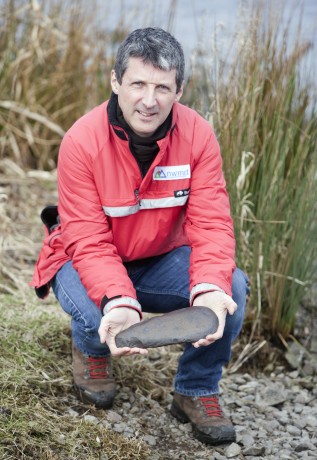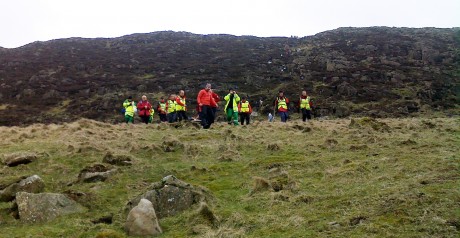
Stephen Forrest, a member of the North West Mountain Rescue Team, who found the Neolithic axe on a Lough Erne Island
DURING the search for missing Kieran McAree on Lough Erne an ancient Neolithic axe, dating back to roughly 3000BC was found on one of Lough Erne’s islands.
Almost two months into the search for Kieran, Stephen Forrest, a volunteer with the North West Mountain Rescue Team, was out with a group on an island, north of Devenish when he made the miraculous discovery.
“I had a pair of waders on and was going through the water when I noticed this stone and it looked unusual so I picked it up. When I saw the edge of it I knew there was something different about it. To cut a long story short I didn’t say too much, but I took it just to get it verified.
“I went to the Ulster Museum and spoke to a Dr Greer Ramsey and he verified it as being Neolithic, between 4,000BC and 2,500 BC, so comfortably 3,000 BC. So that makes it 5,000 years old, that’s three thousand years before Christ and it shows there were men on these islands.”
He continued: “Dr Ramsey said that this particular example, to use his own words, was a ‘real high end example’ and that the museum in Belfast was very interested in it. The way it works is they are donated to them as such, but I said my personal opinion was I wanted it to stay in Fermanagh.”
It is believed the axe is made from a stone called porcellanite, only found in two areas in the world;
Rathlin Island and on the slopes of Tievebullagh Mountain, above Cushendall, County Antrim.
Stephen went on: “They found an axe factory in this area, but they never found any complete axes so what they reckon it arrived here by trading, because they found examples of the stone in the south of England.
“They reckon with the size of that axe it was probably a tree-felling axe, but because the edge is perfect they don’t know if it has been used or what’s happened with it. It’s a polished stone axe. It’s not confirmed as being porcellanite, but it’s highly likely.
“Dr Ramsey had another expert look at it and he wanted to cut into it to investigate further, but we don’t want to do that. It all points to porcellanite though. What’s unusual though is the colour, but 5,000 years in Lough Erne is going to put some different colour on it.”
Originally from Limavady, but living in Enniskillen for the past 12 years, Stephen works for Waterways Ireland as an engineer and in his spare time is part of the North West Mountain Rescue Team. It has been a busy year so far for the group, whose funding is now threatened as part of the swathing cuts across departments.
“For the start of the year there were a lot of organised searches for Kieran, which we were heavily involved with along with the local community and a lot of other rescue groups. It was a very sad affair.“It wasn’t about this find though, the task in hand was to find Kieran and return him to his family. At the end of the day this is only a side issue, something lost, something found.”
Stephen now hopes to speak to Fermanagh County Museum to arrange for the axe to be put on display in the newly refurbished facility in Enniskillen.
To read more.. Subscribe to current edition
Receive quality journalism wherever you are, on any device. Keep up to date from the comfort of your own home with a digital subscription.
Any time | Any place | Anywhere











